
Whenever I plant a new fruit tree, I watch it very closely throughout the year to get to know its growing habits. The first spring after I planted my apricot tree, I eagerly awaited its blossoms. Just like the proverbial “watched pot” which never boils, I felt like I was waiting forever for the tree to bloom.
It turns out, that later-than-expected flowering was a good thing. Apricot tree blossoms are notorious for being easily damaged by frosts – especially in an area with widely fluctuating winter temperatures like mine – destroying any chance for an apricot crop for that year.
Bloom time is one of the most important factors to consider when choosing an apricot tree cultivar for your climate. So when exactly do apricot trees flower?
Apricot trees bloom in early spring between late February and April, depending on the climate and the variety of apricot grown. In areas prone to late frosts, choosing a later-blooming cultivar may prevent the buds and young fruits being damaged by cold spring temperatures.
Understanding an apricot tree’s blossoming habits will help you determine how best to care for your tree. Read on to learn about the different stages of blossoming, how to choose an apricot variety with the right bloom time for your climate, and how to troubleshoot some common blossoming issues.
When do apricot trees bloom?
The answer to this question depends on both the climate and the specific apricot cultivar. An “early blooming” apricot variety might blossom as early as February in areas that warm up quickly in the spring, or as late as the end of April in locations with longer winters.

Apricots generally bloom between February and April (early to mid-spring). Regardless of the exact bloom time, most apricot trees flower for about three weeks total, with full bloom lasting for about one week.
A note about apricot pollination: most apricot trees are self-fertile, so you don’t need a second tree for pollination. However, like with many other fruit trees, self-fertile apricot trees will fruit better if there is a second apricot tree nearby. Just be sure to choose two trees that blossom at about the same time so the bees can zip from flower to flower.
Apricot Tree Blooming Stages
Depending on where you look, there are either 7 or 8 stages to apricot flowering. It’s helpful to know these stages when planning pest management. Certain pest prevention or treatment sprays need to be used at a particular time during dormancy and blooming.
Visit this helpful article from Colorado State to see photos of each flowering stage. This site also includes critical temperature information during the different stages – in other words, at what freezing temperatures the buds or flowers will be harmed.
In a winter with more chill hours, an apricot may have about 80% of its blooms open at the same time. A lower chill winter, the blossoming will be more spread out, with maybe half of the blossoms opening simultaneously (source).
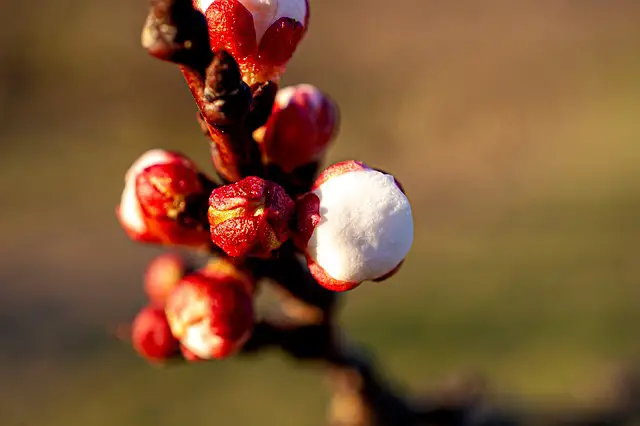
- Bud swell (“first swell”) – Dark purplish-black, tightly closed buds will first appear along and at the tips of branches.
- Tip separation (“swollen bud”) – The closed buds will enlarge and look swollen. You may see the pointed tips start to pull away slightly.
- Pink bud (“red calyx”) – The tips (which are the calyces) will open more, revealing a pinkish-red color in the center of the bud.
- First white (“popcorn stage”) – As the buds begin to open, the unfurled white petals will start to be visible. This is also called the “popcorn stage” because the buds resemble a partially-popped corn kernel (picture above).
- First bloom – At first bloom, the earliest blossoms will open up, while most of the buds remain partially closed.
- Full bloom – At full bloom, the majority of the white blossoms are open.
- Petal fall (“in the shuck”) – This is exactly what it sounds like, when the white petals have fallen off of about 90% of the blossoms.
- Post bloom (“shuck split”) – This is technically a stage that happens after blooming. The calyces turn brown and green baby apricots start to be visible where the flowers were pollinated.
Apricot Varieties by Bloom Time
When choosing an apricot tree to plant, it’s important to consider your climate. Apricots are notorious for losing their blossoms and young fruit to late frosts. Even with relatively mild winters, if your area is prone to cold snaps in late spring, an early-blooming apricot tree may struggle.
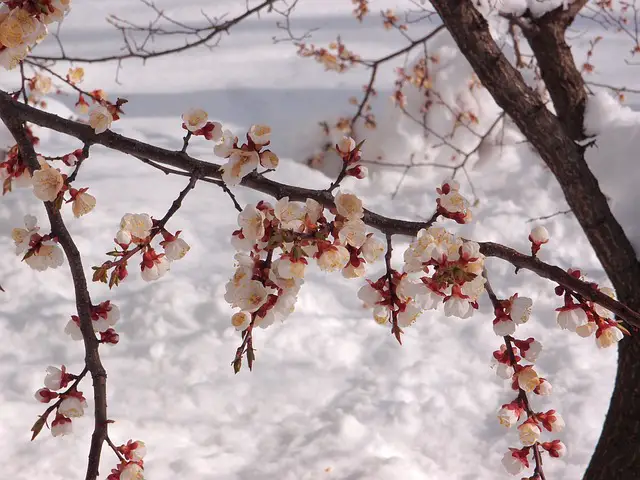
I live in USDA zone 8b, in a subtropical climate with hot, humid summers. Our winters can be deceptive, with long spells of mild weather broken up by intense cold snaps in the teens and 20s (F). This fluctuating weather can (and does) trick an apricot tree into blooming early, wiping out most of the young blossoms or fruit in a freeze.
The other major consideration in choosing an apricot variety is chill hours – the amount of time spent below 45° over the winter. It’s important to choose a variety that needs about the same amount of chill hours that your climate gets on average. You can visit this site for a map with general chill hour estimates, but to find the most accurate information for your area, contact your local extension service.
Late-blooming apricot varieties are best for climates like mine, with fluctuating winter and spring weather, or for areas with longer cold winters. There are late-blooming apricots for low-chill or high-chill areas.
Early-blooming apricots are often grown in areas with consistently mild winter weather, such as much of California (where the majority of apricots are grown commercially in the US). These cultivars typically require low chill hours. If you are able, pair early and late varieties for a longer harvest season of fresh apricots.
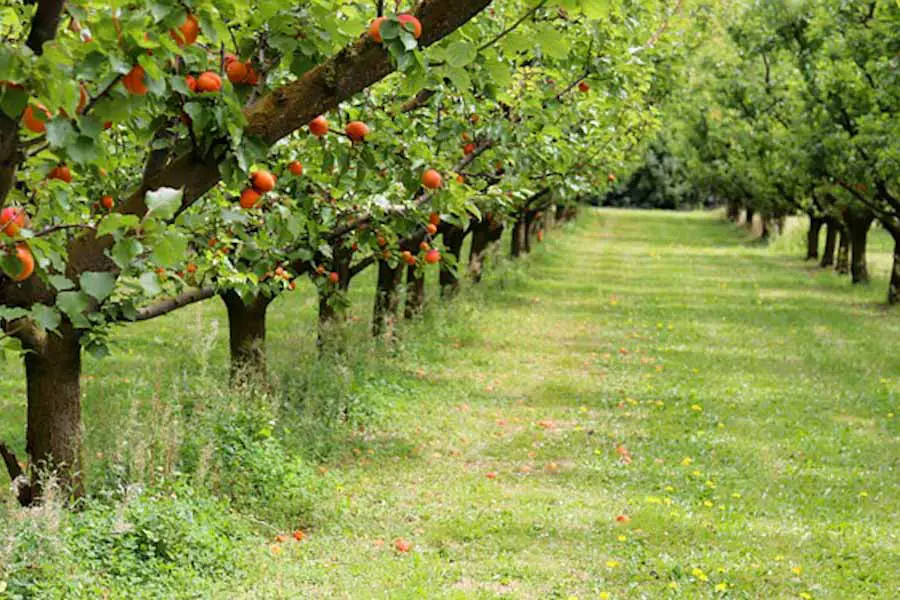
I’ve chosen the low-chill, late-blooming variety ‘Golden Sweet’ apricot tree, and so far so good. The tree is still young (only 4-5 years old while I’m writing this), but we have our first crop of apricots on the tree, even after a couple of late frosts.
One more thing to note – bloom time does not necessarily correspond to harvest time. There are early blooming varieties that take longer to mature and are ready to pick in the middle of the summer. Some later blooming varieties have an early summer harvest. When in doubt, check with local garden centers, your extension service, or your gardening neighbors to see what varieties they’ve had success with.
Early-Blooming Apricots
Apricot varieties that bloom early in the spring include ‘Blenheim’, ‘Tomcot’, ‘Katy’, and ‘Perfection’. The exact bloom time is affected by the climate and specific winter weather.
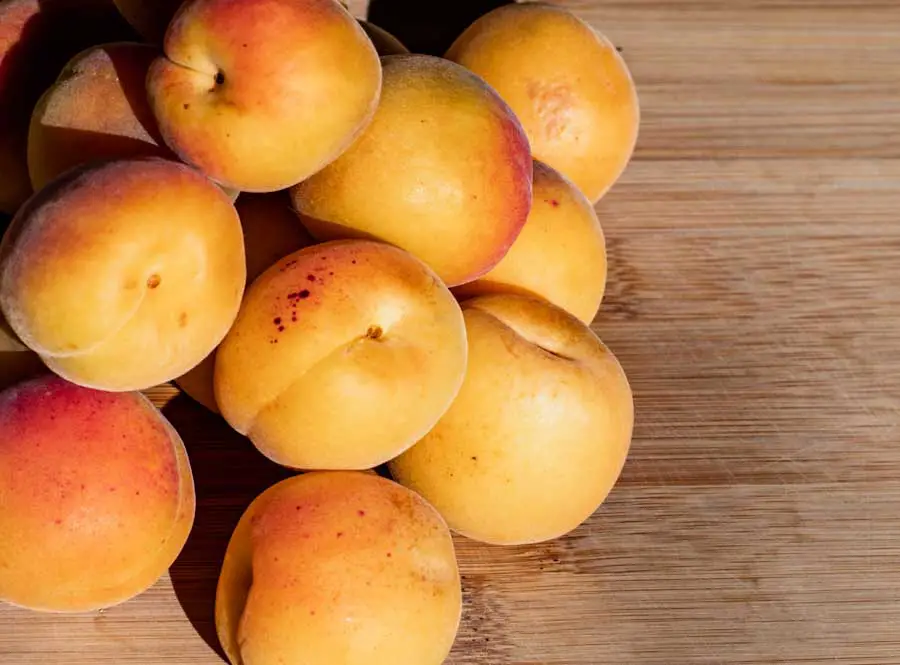
- ‘Blenheim’ – ‘Blenheim’ apricots are small-to-medium sized fruits with yellow-orange flesh. They may still have a slight green tinge to their orange skin even when fully ripe. They are the classic sweet, juicy California apricot, and can be eaten fresh, canned, or dried. Mid-season harvest (late June – July). 300-500 chill hours. Self fertile.
- ‘Tomcot’ – This is a large, sweet, freestone apricot with golden-orange skin. It is frost resistant and performs well in areas that may not typically be ideal for apricots. Early-mid-season harvest (June – early July). 500 chill hours. Partially self-fertile.
- ‘Katy’ – ‘Katy’ produces lightly sweet yellow-orange apricots early in the season. It is very productive and fast-growing. Early harvest (May – early June). 200-300 chill hours. Self-fertile.
- ‘Perfection’ – This tree stays only 6-8 feet tall, and blooms in early to mid spring (March in most areas). It is very resistant to cold (down to -25°F), but its early blossoms could be susceptible to late frosts. ‘Perfection’ grows large, sweet apricots that are perfect for eating fresh, preserving, or drying. Mid-season harvest (late June-July). 700 chill hours.
Late Blooming
Late-blooming apricot cultivars include ‘Moorpark’, ‘Golden Sweet’, ‘Harglow’ and ‘Chinese’/’Mormon’. Apricot trees that bloom later in spring are less susceptible to frost damage.

- ‘Moorpark’ – ‘Moorpark’ apricots are sweet, large, and have yellow-orange skin. They’re well suited to areas with wet spring weather. Fruit ripens in stages, so apricots are ready for harvest over a long period of time. Late-season harvest (July – early August). 600 chill hours. Self-fertile.
- ‘Golden Sweet’ – ‘Golden Sweet’ is very adaptable to climates that are not traditionally apricot-friendly. They produce medium-sized, sweet, golden-orange apricots that ripen later than most. The trees reach 15-18 feet tall and are disease resistant. Late-season harvest (July – early August). 400-500 chill hours. Self-fertile.
- ‘Harglow’ – ‘Harglow’ is a large, deep orange apricot with a reddish tinge, and it has excellent texture and overall flavor. Resistant to bacterial canker and brown rot. The tree is naturally compact, but productive. Mid-late-season harvest (July – early August). 800 chill hours. Self-fertile.
- ‘Chinese’ (‘Mormon’) – This is a semi-dwarf tree that tolerates late frosts well. It is perfect for climates with short growing seasons, as they flower late but fruit relatively early. ‘Chinese’ apricots are medium-sized, mildly sweet, and uniformly yellow-orange when ripe. Mid-season harvest (late June – early July). 700 chill hours. Self fertile.
What Else to Know About Apricot Tree Blossoming?

Do apricot trees flower before leaves form?
Leaf buds emerge on apricot trees after the flowers bloom and fall off. Apricot trees are deciduous, so the leaves fall in autumn and the tree goes dormant to conserve energy and protect itself over the winter. As the weather warms, the flower buds form, then open, followed by the leaves.
How can you delay an apricot tree blooming?
There is only so much you can do to affect the timing of apricot blossoms. After all, bloom time is largely determined by the variety, climate, and winter/spring weather. However, you may be able to delay bloom slightly by applying a thick layer of mulch around the base of the tree.
While the ground is still cold or frozen, spread an organic mulch (conifer bark, pine needles, leaves, etc.) at least a foot thick around the apricot tree to its dripline. Leave about 6 inches of space around the trunk to prevent rot.
This reverse-insulation will keep the ground from warming up as quickly. The spring sunshine will heat up the mulch before it can reach the ground and roots. This may delay the tree’s blooms enough to prevent spring frost damage.
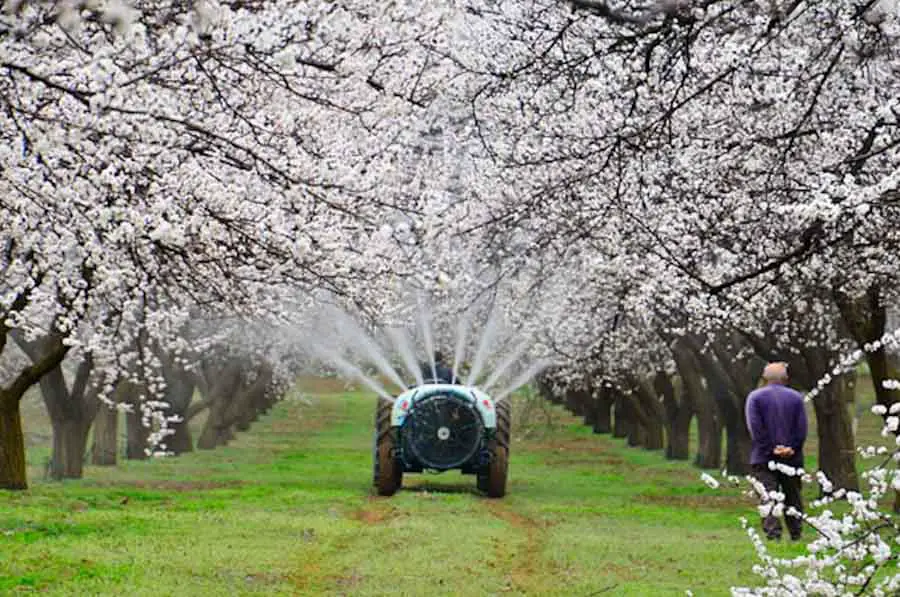
Commercial orchards sometimes use other methods to delay blooming, such as “evaporative cooling,” where buds are sprayed with water to cool them down and protect them from freezing temperatures. However, these methods can cause more harm than good for the home gardener if not done correctly.
Why isn’t my apricot tree flowering?
Apricot trees may fail to blossom either partially or completely due to age, over-pruning, cold damage, or lack of chill hours. Young apricot trees need at least 2 to 3 years of growth before fruiting, so a lack of blossoms could mean the tree is not mature enough to bloom.
Although pruning is an essential part of apricot tree care, overly aggressive pruning could prevent the tree from forming flower buds the following year. Apricots fruit on 2-year-old wood, so if you accidentally removed too much, it could struggle to blossom.
As we’ve discussed throughout this article, winter weather has a large effect on apricot blossoms. If the winter was milder than usual, the tree may not receive enough chill hours for flower buds to form and emerge. Buds can also be damaged by late winter or early spring frosts, preventing the tree from flowering.

